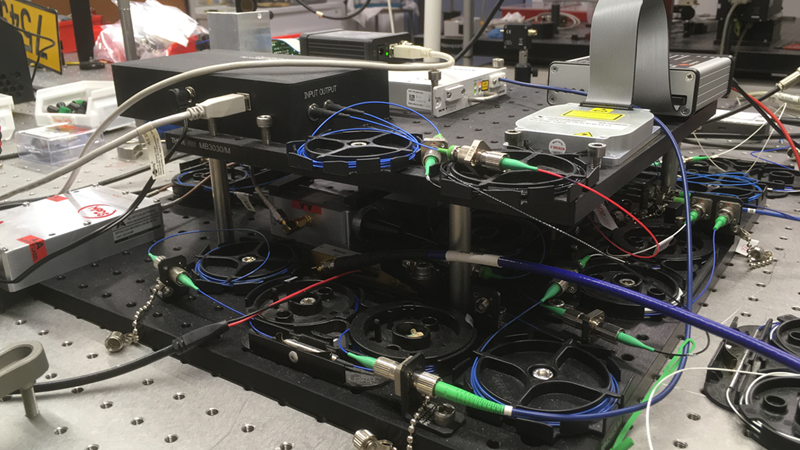Photonic technology enables real-time calculation of radio signal correlation
About Optica
24 March 2022
Photonic technology enables real-time calculation of radio signal correlation
Light-based approach can be used to locate phones and other signal-emitting devices, outperforms digital methods
WASHINGTON — Researchers have developed a new analog photonic correlator that can be used to locate an object transmitting a radio signal. Because the new correlator is faster than other methods and works with a wide range of radio frequency signals, it could be useful for locating cell phones, signal jammers or a variety of tracking tags.
“The photonic architecture we developed uses no moving parts and enables real-time signal processing,” said Hugues Guillet de Chatellus from Université Grenoble Alpes-CNRS in France. “Real-time processing helps ensure there isn’t any downtime, which is critical for defense applications, for example.”

Caption: : Researchers developed a new analog photonic correlator that can be used to locate an object transmitting a radio signal. The new correlator could be useful for locating cell phones, signal jammers or a variety of tracking tags. The optical setup used for the research is pictured.
Image Credit: Hugues Guillet de Chatellus, Université Grenoble Alpes-CNRS
In Optica, Optica Publishing Group’s journal for high-impact research, Guillet de Chatellus and colleagues describe the new photonic correlator and demonstrate its ability to identify the location of a radio frequency transmitter. The device is considerably simpler than today’s analog or digital correlators and uses off-the-shelf telecommunications components.
“Many of today’s radio signals have large bandwidths because they carry a great deal of information,” said Guillet de Chatellus. “Our photonic approach offers a simple method for correlating signals with bandwidths of up to a few GHz, a larger bandwidth than is available from commercial approaches based on purely digital techniques.”
Using light to calculate correlation
The new photonic correlator can be used to compute what is known as a cross-correlation function for two signals emitted from one source and detected by two antennas. This measures the similarity of the signals as a function of the displacement of one signal relative to the other and provides information about their relative delay, which can be used to calculate the location of the signal’s source.
“The photonic architecture we developed enables real-time calculation of the cross-correlation function of two input signals for about 200 values of relative delay simultaneously,” said Guillet de Chatellus. “This is much higher than any photonic technique has been able to accomplish so far.”
The correlator works like a photonic processor by using fiber optic components to turn two radio-frequency signals into optical signals. Once the cross-correlation function is calculated, a detection and processing chain enables it to be converted into a digital format.
The most critical component of the new system is a frequency shifting loop, which can generate and manipulate a large number of time-shifted replicas for an input signal. This simple photonic component has enabled many recent innovations in microwave photonics.
“We’ve been developing frequency shifting loops for some time, and a deep understanding of their architecture led us to apply them to this new application,” said Guillet de Chatellus. “This work shows that photonics can offer efficient alternatives to solutions that are based on digital electronics.”
Precision location
After testing their new device using high-power simple signals, the researchers tested it with more complex signals and then moved to signals propagating through free space and received by a pair of antennas. The researchers were able to demonstrate localization of a radiofrequency transmitter with a precision close to 10 picoseconds for a 100-millisecond integration time. This means that the system could locate an emitter with a precision of about 3 millimeters.
The new analog photonic correlator can also be used in astronomy to cross-correlate signals coming from several telescopes to create high-resolution images. In the coming months, the researchers plan to work on a demonstration experiment in which signals emitted from the sun at around 10 GHz will be collected by two remote antennas and cross-correlated using the new photonic device to create an image of the sun at radio-wavelength.
If these experiments are successful, this device could initiate infrared applications in astronomy facilities, such as the Very Large Telescope Interferometer in Chile, using heterodyne interferometry. Heterodyne interferometry has been used for radio-interferometry but was previously limited to narrow correlation bandwidths.
The researchers are also performing experiments to find out if the new photonic correlator can be used to correlate three signals, which would enable 3D localization of transmitters by triangulation. They also plan further work to miniaturize and fully integrate the correlator.
Paper: G. Bourdarot, J.-P. Berger, H. Guillet de Chatellus, “Multi-delay photonic correlator for wideband RF signal processing” Optica 9, 325-334 (2022). https://doi.org/10.1364/OPTICA.442906.
About Optica Publishing Group
Optica Publishing Group is a division of the society, Optica, Advancing Optics and Photonics Worldwide. It publishes the largest collection of peer-reviewed and most-cited content in optics and photonics, including 18 prestigious journals, the society’s flagship member magazine, and papers and videos from more than 835 conferences. With over 400,000 journal articles, conference papers and videos to search, discover and access, our publications portfolio represents the full range of research in the field from around the globe.
About Optica
Optica is an open-access journal dedicated to the rapid dissemination of high-impact peer-reviewed research across the entire spectrum of optics and photonics. Published monthly by Optica Publishing Group, the Journal provides a forum for pioneering research to be swiftly accessed by the international community, whether that research is theoretical or experimental, fundamental or applied. Optica maintains a distinguished editorial board of more than 60 associate editors from around the world and is overseen by Editor-in-Chief Prem Kumar, Northwestern University, USA. For more information, visit Optica.
Media Contact
